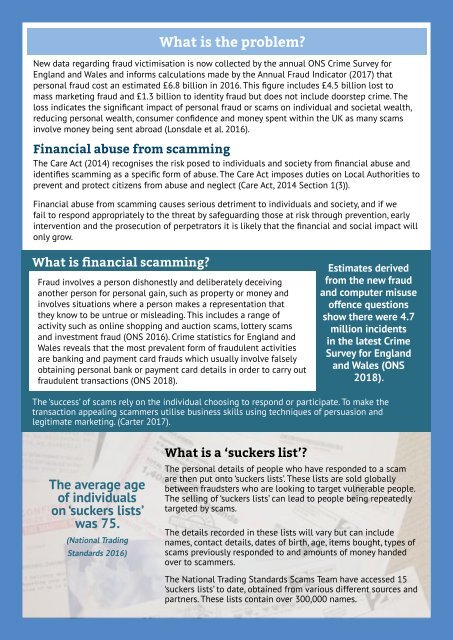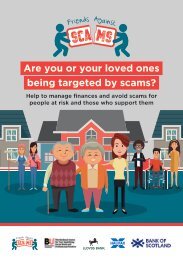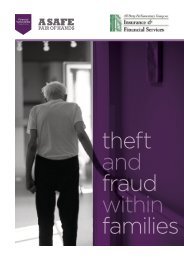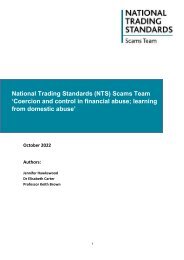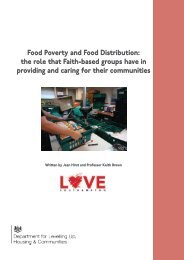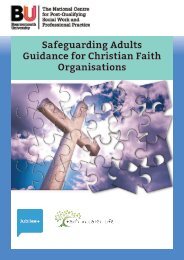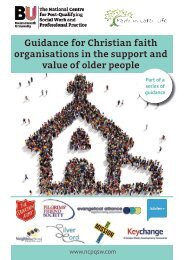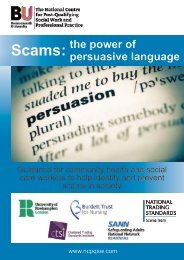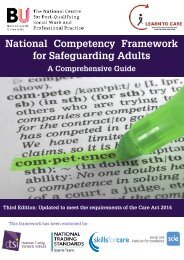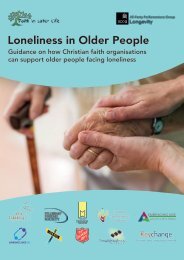Financial Scamming and Fraud
Financial scamming and its impact have been receiving a higher public profile in recent months, yet though it is recognised as a growing problem, there is a lack of clear research and evidence into the scale of the problem, its causes and the impact on the public.
Financial scamming and its impact have been receiving a higher
public profile in recent months, yet though it is recognised as a
growing problem, there is a lack of clear research and evidence
into the scale of the problem, its causes and the impact on the
public.
You also want an ePaper? Increase the reach of your titles
YUMPU automatically turns print PDFs into web optimized ePapers that Google loves.
What is the problem?<br />
New data regarding fraud victimisation is now collected by the annual ONS Crime Survey for<br />
Engl<strong>and</strong> <strong>and</strong> Wales <strong>and</strong> informs calculations made by the Annual <strong>Fraud</strong> Indicator (2017) that<br />
personal fraud cost an estimated £6.8 billion in 2016. This figure includes £4.5 billion lost to<br />
mass marketing fraud <strong>and</strong> £1.3 billion to identity fraud but does not include doorstep crime. The<br />
loss indicates the significant impact of personal fraud or scams on individual <strong>and</strong> societal wealth,<br />
reducing personal wealth, consumer confidence <strong>and</strong> money spent within the UK as many scams<br />
involve money being sent abroad (Lonsdale et al. 2016).<br />
<strong>Financial</strong> abuse from scamming<br />
The Care Act (2014) recognises the risk posed to individuals <strong>and</strong> society from financial abuse <strong>and</strong><br />
identifies scamming as a specific form of abuse. The Care Act imposes duties on Local Authorities to<br />
prevent <strong>and</strong> protect citizens from abuse <strong>and</strong> neglect (Care Act, 2014 Section 1(3)).<br />
<strong>Financial</strong> abuse from scamming causes serious detriment to individuals <strong>and</strong> society, <strong>and</strong> if we<br />
fail to respond appropriately to the threat by safeguarding those at risk through prevention, early<br />
intervention <strong>and</strong> the prosecution of perpetrators it is likely that the financial <strong>and</strong> social impact will<br />
only grow.<br />
What is financial scamming?<br />
<strong>Fraud</strong> involves a person dishonestly <strong>and</strong> deliberately deceiving<br />
another person for personal gain, such as property or money <strong>and</strong><br />
involves situations where a person makes a representation that<br />
they know to be untrue or misleading. This includes a range of<br />
activity such as online shopping <strong>and</strong> auction scams, lottery scams<br />
<strong>and</strong> investment fraud (ONS 2016). Crime statistics for Engl<strong>and</strong> <strong>and</strong><br />
Wales reveals that the most prevalent form of fraudulent activities<br />
are banking <strong>and</strong> payment card frauds which usually involve falsely<br />
obtaining personal bank or payment card details in order to carry out<br />
fraudulent transactions (ONS 2018).<br />
Estimates derived<br />
from the new fraud<br />
<strong>and</strong> computer misuse<br />
offence questions<br />
show there were 4.7<br />
million incidents<br />
in the latest Crime<br />
Survey for Engl<strong>and</strong><br />
<strong>and</strong> Wales (ONS<br />
2018).<br />
The ‘success’ of scams rely on the individual choosing to respond or participate. To make the<br />
transaction appealing scammers utilise business skills using techniques of persuasion <strong>and</strong><br />
legitimate marketing. (Carter 2017).<br />
The average age<br />
of individuals<br />
on ‘suckers lists’<br />
was 75.<br />
(National Trading<br />
St<strong>and</strong>ards 2016)<br />
What is a ‘suckers list’?<br />
The personal details of people who have responded to a scam<br />
are then put onto ‘suckers lists’. These lists are sold globally<br />
between fraudsters who are looking to target vulnerable people.<br />
The selling of ‘suckers lists’ can lead to people being repeatedly<br />
targeted by scams.<br />
The details recorded in these lists will vary but can include<br />
names, contact details, dates of birth, age, items bought, types of<br />
scams previously responded to <strong>and</strong> amounts of money h<strong>and</strong>ed<br />
over to scammers.<br />
The National Trading St<strong>and</strong>ards Scams Team have accessed 15<br />
‘suckers lists’ to date, obtained from various different sources <strong>and</strong><br />
partners. These lists contain over 300,000 names.


